Post-Harvest Treatment with Methyl Jasmonate Impacts Lipid Metabolism in Tomato Pericarp (Solanum lycopersicum L. cv. Grape) at Different Ripening Stages
Abstract
1. Introduction
2. Materials and Methods
2.1. Plant Material and Post-Harvest Treatment
2.2. Ripening Parameters
2.2.1. Ethylene Emission
2.2.2. Fruit Surface Color
2.3. Analysis of Metabolite Profiling of Tomato Fruit Using GC-MS
2.3.1. Extraction and Derivatization of Polar Metabolites
2.3.2. Extraction and Derivatization of Non-Polar Metabolites
2.3.3. GC-MS Analysis
2.4. Analysis of Carotenoids by HPLC
2.5. Statistical Analysis
3. Results and Discussion
3.1. Effect of Methyl Jasmonate on the Ethylene Emission and Fruit Surface Color of Tomatoes
3.2. Primary Metabolite Profiling Affected by Post-Harvest Hormone Treatment
3.3. Secondary Metabolite Profiling Affected by Post-Harvest Hormone Treatment
3.4. Lipid Metabolism Affected by the Post-Harvest Jasmonate Treatment
Supplementary Materials
Author Contributions
Funding
Institutional Review Board Statement
Informed Consent Statement
Data Availability Statement
Acknowledgments
Conflicts of Interest
References
- Tang, N.; Na, J.; Deng, W.; Gao, Y.; Chen, Z.; Li, Z. Metabolic and transcriptional regulatory mechanism associated with postharvest fruit ripening and senescence in cherry tomatoes. Postharvest Biol. Technol. 2020, 168, 111274. [Google Scholar] [CrossRef]
- Tieman, D.; Zhu, G.; Resende, M.F.; Lin, T.; Nguyen, C.; Bies, D.; Rambla, J.L.; Ortiz Beltran, K.S.; Taylor, M.; Zhang, B.; et al. A chemical genetic roadmap to improved tomato flavor. Science 2017, 355, 391–394. [Google Scholar] [CrossRef] [PubMed]
- Bramley, B.M. Regulation of carotenoid formation during tomato fruit ripening and development. J. Exp. Bot. 2002, 53, 2107–2113. [Google Scholar] [CrossRef] [PubMed]
- Almeida, J.; Asís, R.; Molineri, V.N.; Sestari, I.; Lira, B.S.; Carrari, F.; Pereira Peres, L.E.; Rossi, M. Fruits from ripening impaired, chlorophyll degraded and jasmonate insensitive tomato mutants have altered tocopherol content and composition. Phytochemistry 2015, 111, 72–83. [Google Scholar] [CrossRef]
- Moreau, R.A.; Nyström, L.; Whitaker, B.D.; Winkler-Moser, J.K.; Baer, D.J.; Gebauerf, S.K.; Hicks, K.B. Phytosterols and their derivatives: Structural diversity, distribution, metabolism, analysis, and health-promoting uses. Prog. Lipid Res. 2018, 70, 35–61. [Google Scholar] [CrossRef] [PubMed]
- Kumar, A.; Singh, P.K.; Parihar, R.; Dwivedi, V.; Lakhotia, S.C.; Ganesh, S. Decreased O-linked GlcNAcylation protects from cytotoxicity mediated by huntingtin Exon1 protein fragment. J. Biol. Chem. 2014, 289, 13543–13553. [Google Scholar] [CrossRef] [PubMed]
- Prasanna, V.; Prabha, T.N.; Tharanathan, R.N. Fruit ripening phenomena—An overview. Crit. Rev. Food Sci. Nutr. 2007, 47, 1–19. [Google Scholar] [CrossRef]
- Farmer, E.E.; Ryan, C.A. Octadecanoid precursors of jasmonic acid activate the synthesis of wound-inducible proteinase inhibitors. Plant Cell 1992, 4, 129–134. [Google Scholar] [CrossRef]
- Fan, X.; Mattheis, J.P.; Fellman, J.K. A role for jasmonates in climacteric fruit ripening. Planta 1998, 204, 444–449. [Google Scholar] [CrossRef]
- Zhang, Z.; Huber, D.J.; Rao, J. Delay of tomato fruit ripening in response to 1-methylcyclopropene is influenced by internal ethylene levels. Postharvest Biol. Technol. 2009, 54, 1–8. [Google Scholar] [CrossRef]
- Su, H.; Gubler, W.D. Effect of 1-methylcyclopropene (1-MCP) on reducing postharvest decay in tomatoes (Solanum lycopersicum L.). Postharvest Biol. Technol. 2012, 64, 133–137. [Google Scholar] [CrossRef]
- Cliff, M.; Lok, S.; Lu, C.; Toivonen, P.M.A. Effect of 1-methylcyclopropene on the sensory, visual, and analytical quality of greenhouse tomatões. Postharvest Biol. Technol. 2009, 53, 11–15. [Google Scholar] [CrossRef]
- Fabi, J.P.; Cordenunsi, B.R.; Barreto, G.P.d.M.; Mercadante, A.Z.; Lajolo, F.M.; Nascimento, J.R.O. Papaya fruit ripening: Response to ethylene and 1-methylciclopropene. J. Agric. Food Chem. 2007, 55, 6118–6123. [Google Scholar] [CrossRef] [PubMed]
- Lisec, J.; Schauer, N.; Kopka, J.; Willmitzer, L.; Fernie, A.R. Gas chromatography mass spectrometry-based metabolite profiling in plants. Nat. Protoc. 2006, 1, 387–396. [Google Scholar] [CrossRef]
- Kind, T.; Wohlgemuth, G.; Lee, D.Y.; Lu, Y.; Palazoglu, M.; Shahbaz, S.; Fiehn, O. FiehnLib: Mass spectral and retention index libraries for metabolomics based on quadrupole and time-of-flight gas chromatography/mass spectrometry. Anal. Chem. 2009, 81, 10038–10048. [Google Scholar] [CrossRef] [PubMed]
- Bligh, E.G.; Dyer, W.J. A rapid method of total lipid extraction and purification. Can. J. Biochem. Physiol. 1959, 37, 911–917. [Google Scholar] [CrossRef] [PubMed]
- Ichihara, K.I.; Fukubayashi, Y. Preparation of fatty acid methyl esters for gas-liquid chromatography. J. Lipid Res. 2010, 51, 635–640. [Google Scholar] [CrossRef] [PubMed]
- Fiehn, O.; Kopka, J.; Dörmann, P.; Altmann, T.; Trethewey, R.N.; Willmitzer, L. Metabolite profiling for plant functional genomics. Nat. Biotechnol. 2000, 18, 1157–1161. [Google Scholar] [CrossRef]
- Sérino, S.; Gomez, L.; Costagliola, G.; Gautier, H. HPLC assay of tomato carotenoids: Validation of a rapid microextraction technique. J. Agric. Food Chem. 2009, 57, 8753–8760. [Google Scholar] [CrossRef]
- da Silva Souza, M.A.; Peres, L.E.; Freschi, J.R.; Purgatto, E.; Lajolo, F.M.; Hassimotto, N.M. Changes in flavonoid and carotenoid profiles alter volatile organic compounds in purple and orange cherry tomatoes obtained by allele introgression. J. Sci. Food Agric. 2019, 100, 1662–1670. [Google Scholar] [CrossRef]
- Chong, J.; Soufan, O.; Li, C.; Caraus, I.; Li, S.; Bourque, G.; Wishart, D.S.; Xia, J. MetaboAnalyst 4,0: Towards more transparent and integrative metabolomics analysis. Nucl. Acids Res. 2018, 46, W486–W494. [Google Scholar] [CrossRef] [PubMed]
- Guillén, F.; Castillo, S.; Zapata, P.; Martínez-Romero, D.; Serrano, M.; Valero, D. Efficacy of 1-MCP treatment in tomato fruit. 1. Duration and concentration of 1-MCP treatment to gain an effective delay of postharvest ripening. Postharvest Biol. Technol. 2007, 43, 23–27. [Google Scholar] [CrossRef]
- Blankenship, S.M.; Dole, J.M. 1-Methylcyclopropene: A review. Postharvest Biol. Technol. 2003, 28, 1–25. [Google Scholar] [CrossRef]
- Beauvoit, B.; Belouah, I.; Bertin, N.; Cakpo, C.B.; Colombié, S.; Dai, Z.; Gautier, H.; Génard, M.; Moing, A.; Roch, L.; et al. Putting primary metabolism into perspective to obtain better fruits. Ann. Bot. 2018, 122, 1–21. [Google Scholar] [CrossRef]
- Durazzo, A.; Azzini, E.; Foddai, M.S.; Nobili, F.; Garaguso, I.; Raguzzini, A.; Finotti, E.; Tisselli, V.; Del Vecchio, S.; Piazza, C.; et al. Influence of different crop management practices on the nutritional properties and benefits of tomato -Lycopersicon esculentum cv Perfectpeel-. Int. J. Food Sci. Technol. 2010, 45, 2637–2644. [Google Scholar] [CrossRef]
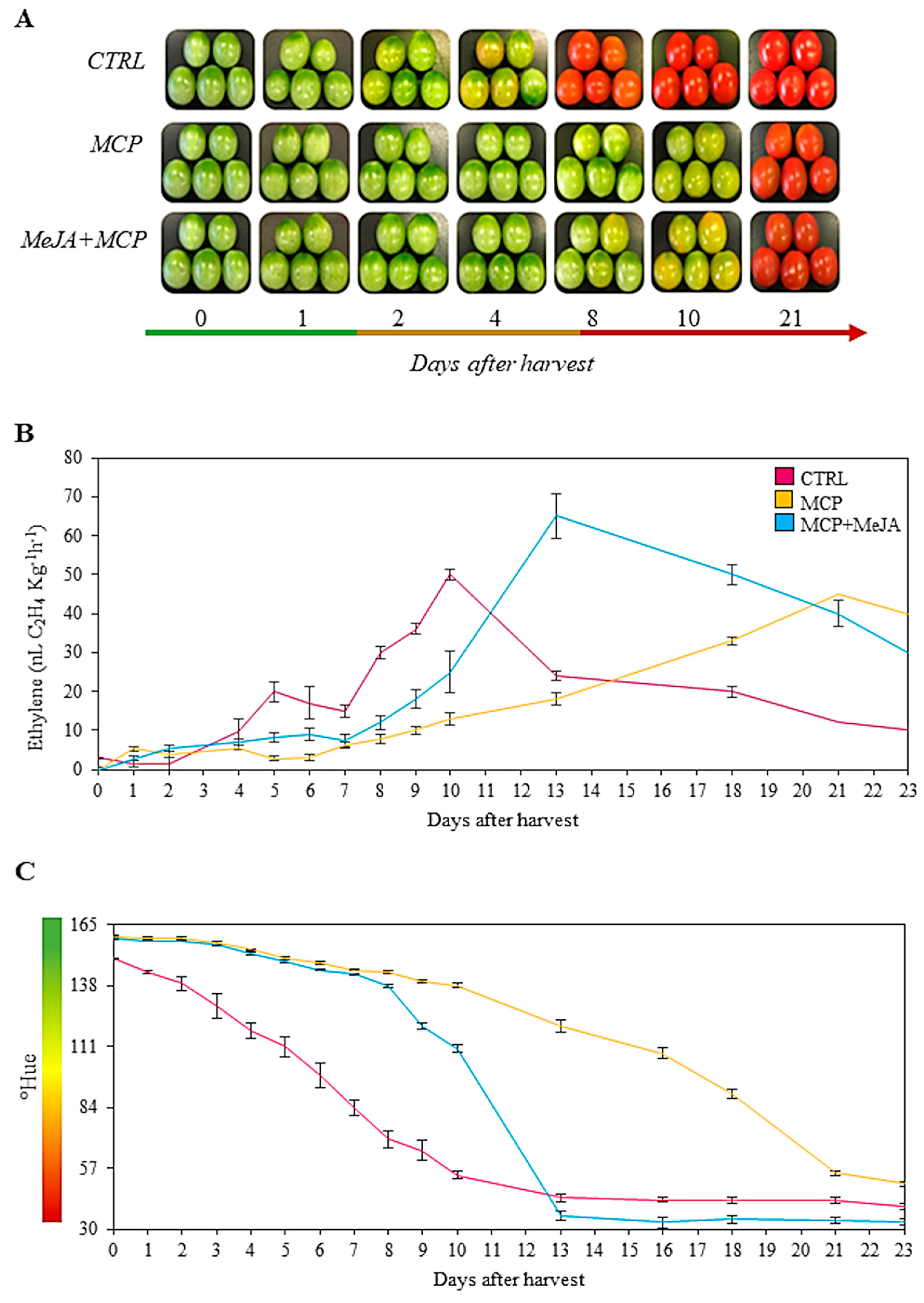
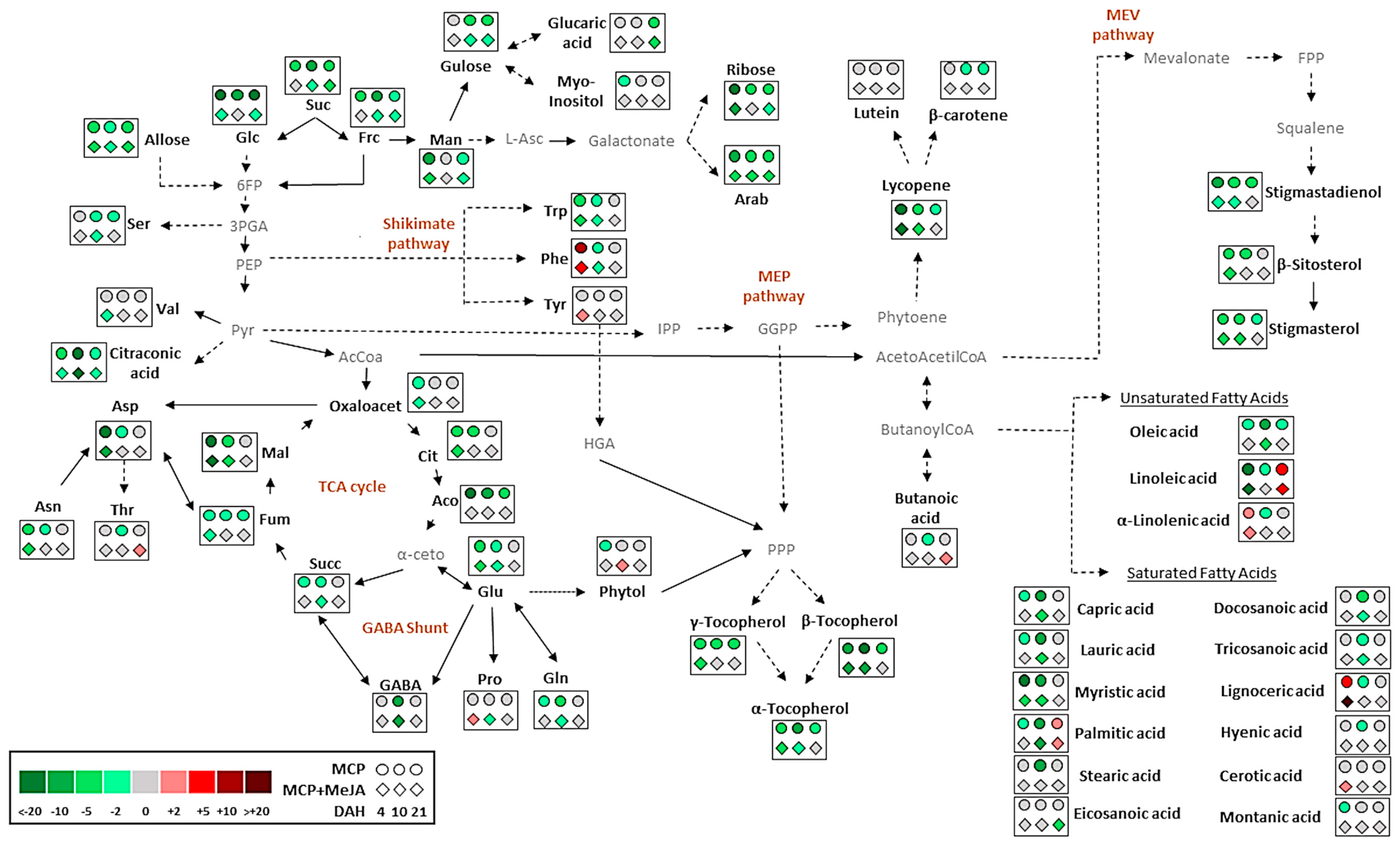
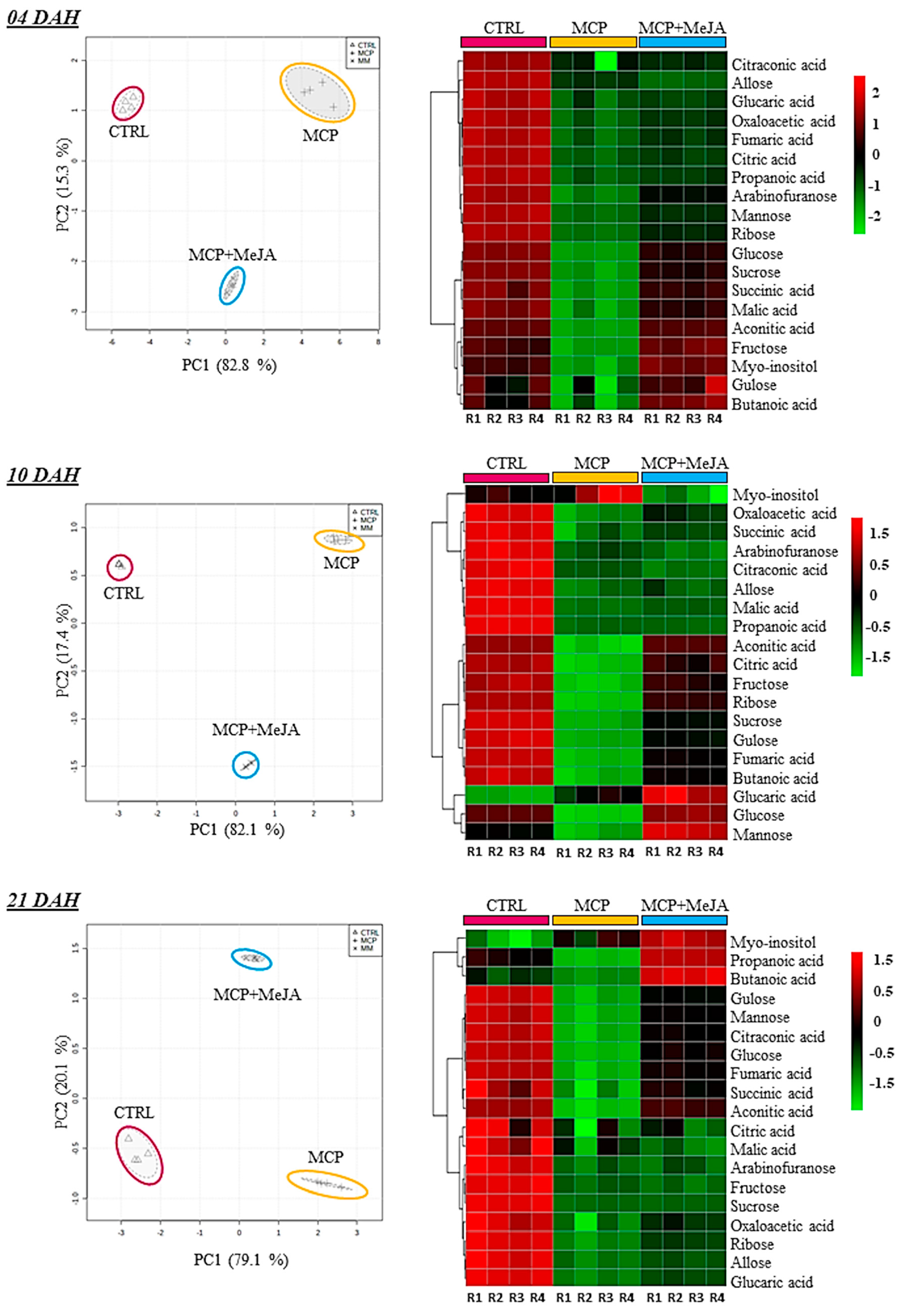
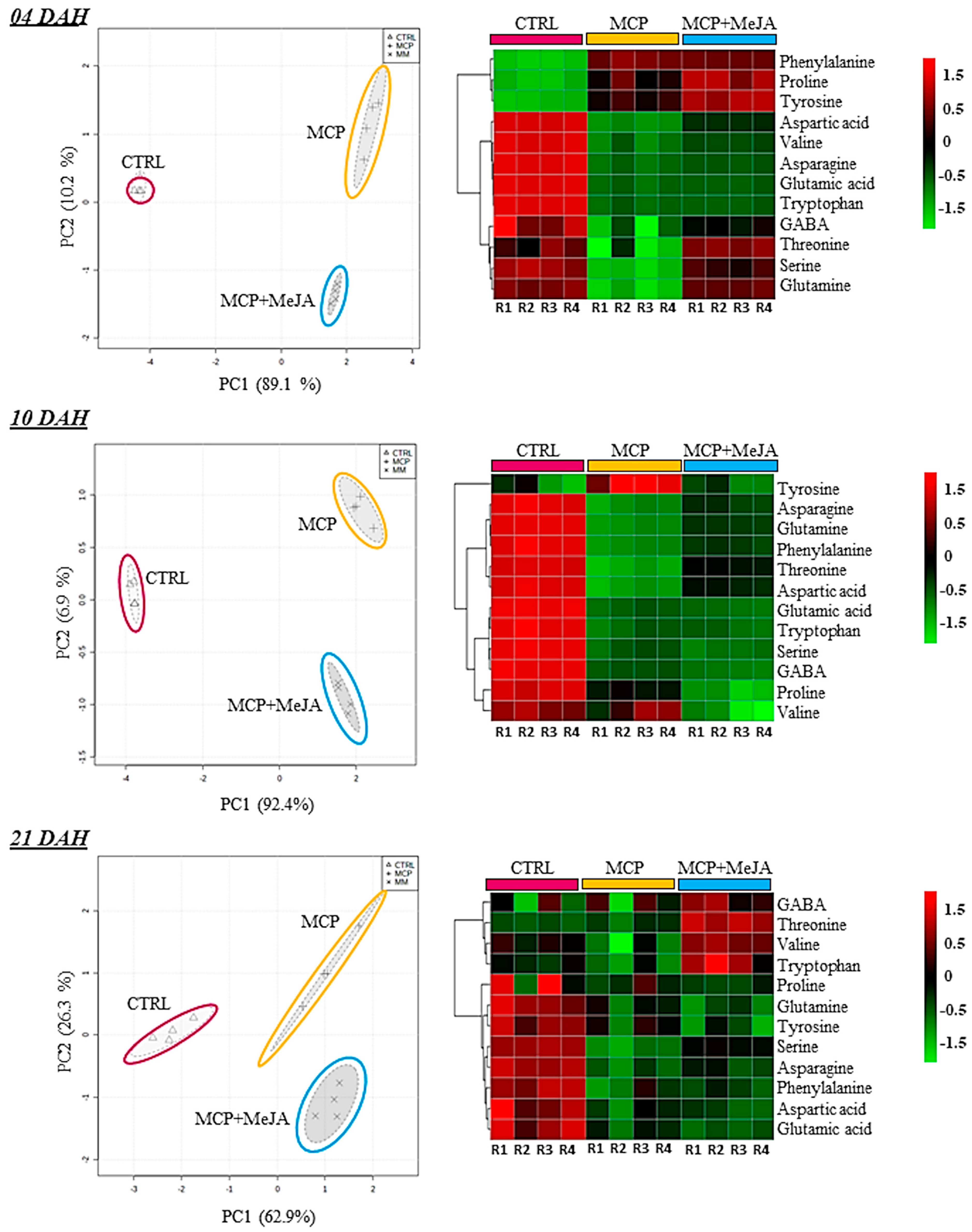
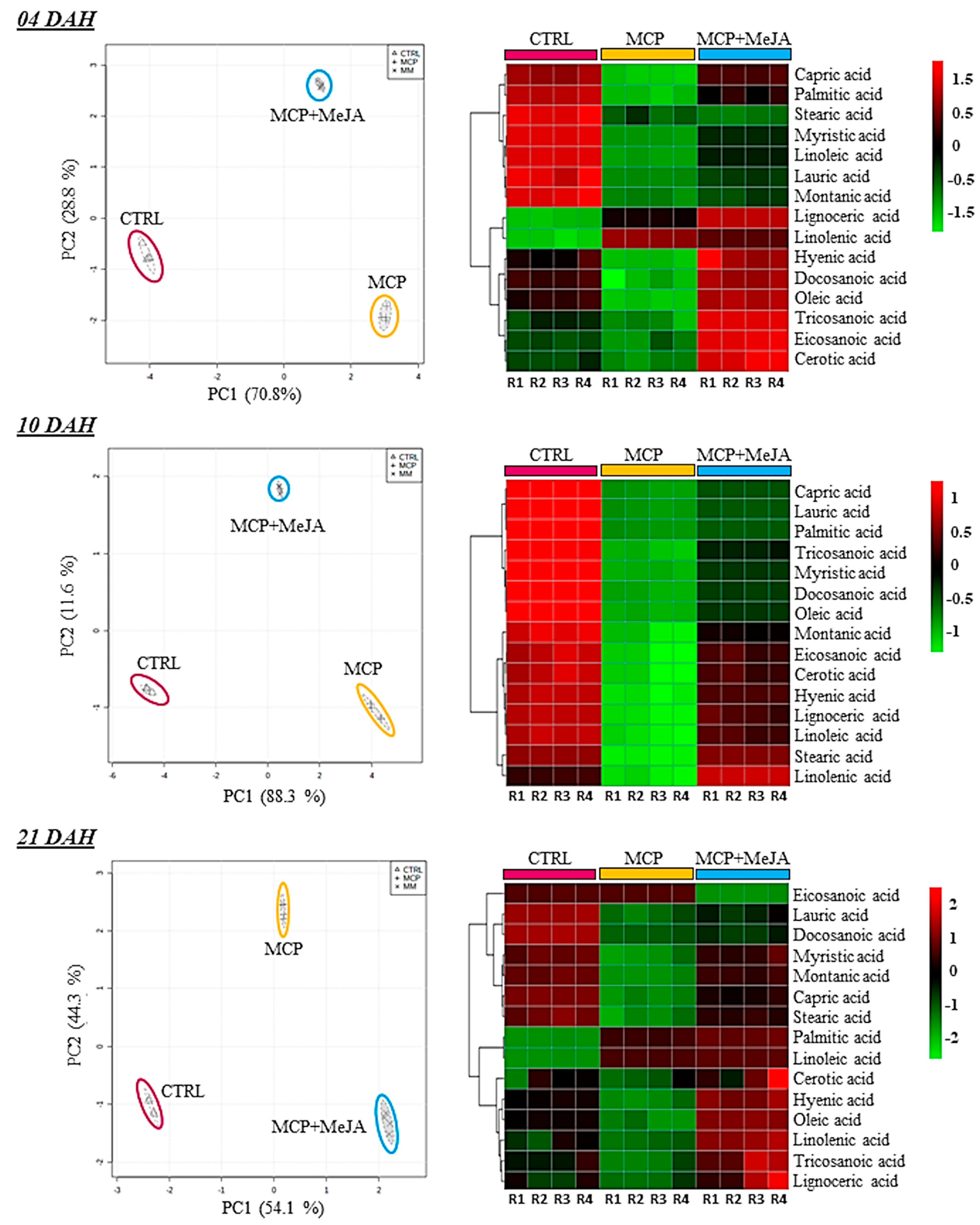
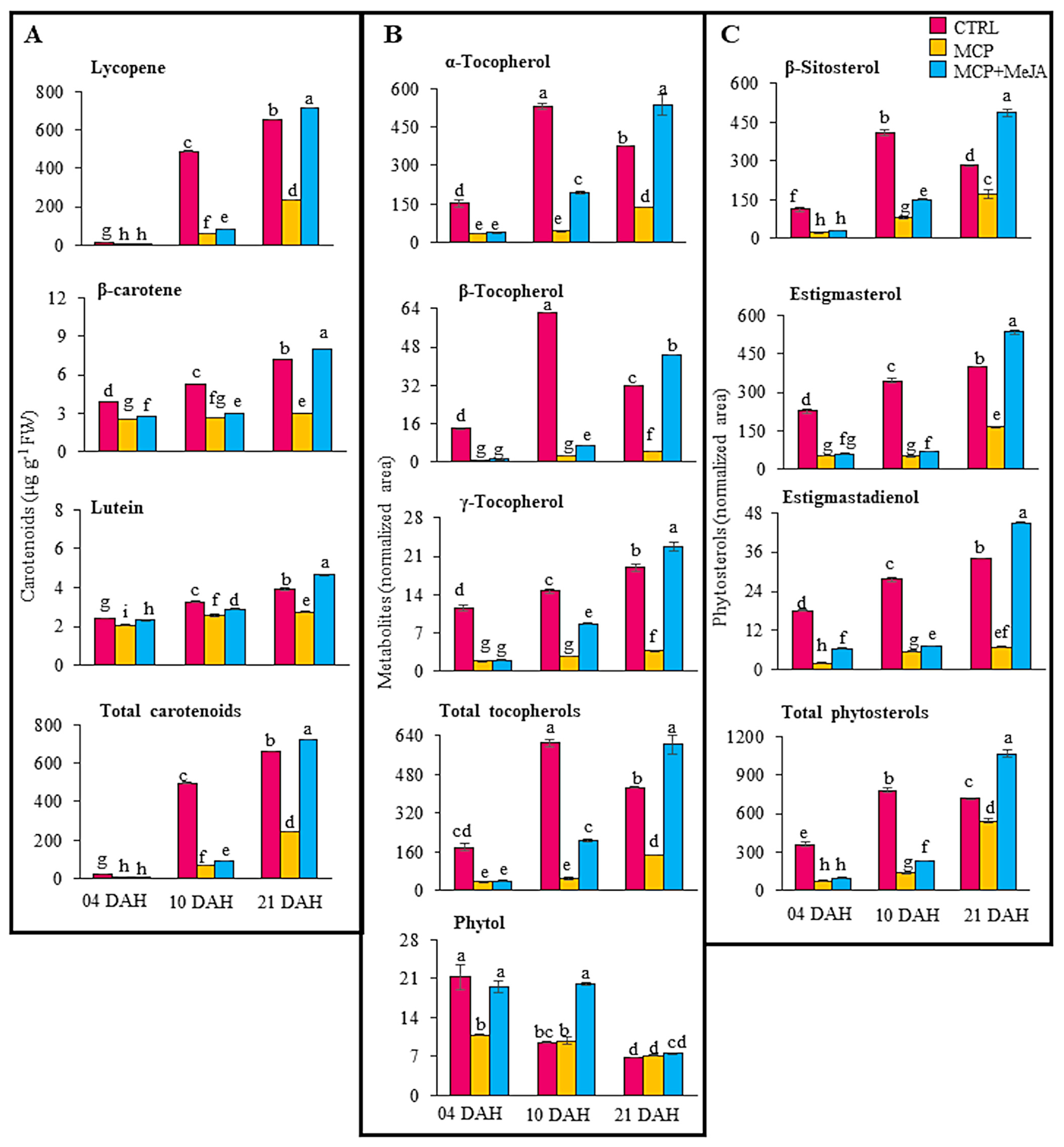
| Metabolite | 4 DAH | 10 DAH | 21 DAH | ||||||
|---|---|---|---|---|---|---|---|---|---|
| CTRL | MCP | MCP + MeJA | CTRL | MCP | MCP + MeJA | CTRL | MCP | MCP + MeJA | |
| Sugars | |||||||||
| Glucose | 1534.5 ± 76.0 d | 70.6 ± 4.7 g | 598.7 ± 37.9f | 1977.6 ± 11.4 c | 156.5 ± 7.5 g | 2977.0 ± 253.0 b | 4352.0 ± 281.0 a | 189.4 ± 15.2 g | 1112.6 ± 140.1 e |
| Fructose | 27474.0 ± 4039.0 d | 3935.0 ± 489.0 e | 37418.0 ± 5231.0 c | 59266.0 ± 6310.0 b | 4858.0 ± 544.0 e | 26343.0 ± 3352.0 d | 101194.0 ± 5662.0 a | 25944.0 ± 1592.0 d | 24324.0 ± 1808.0 d |
| Sucrose | 38205.0 ± 569.0 c | 5105.0 ± 559.0 f | 20507.0 ± 1161.0 d | 54654.0 ± 716.0 b | 3661.0 ± 356.0 f | 11961.0 ± 469.0 e | 84839.0 ± 4545.0 a | 10885.0 ± 358.0 e | 11248.0 ± 284.0 e |
| Allose | 1098.6 ± 44.2 c | 172.6 ± 12.6 ef | 115.1 ± 4.8 f | 1563.4 ± 21.5 b | 630.6 ± 39.0 d | 687.0 ± 56.9 d | 3309.0 ± 380.0 a | 469.1 ± 49.6 d,e | 584.1 ± 27.8 d |
| Gulose | 221.5 ± 9.8 d | 196.9 ± 15.1 d | 229.8± 10.9 d | 790.4 ± 38.3 b | 92.6 ± 4.5 e | 228.8 ± 10.4 d | 1017.0 ± 60.4 a | 183.5 ± 17.6 d | 404.0 ± 12.9 c |
| Glucaric acid | 42.2 ± 1.6 d | 21.9 ± 2.1 e | 23.1 ± 0.4 e | 72.0 ± 1.30 c | 93.4 ± 6.3 b | 126.7 ± 8.5 a | 124.6 ± 8.7 a | 15.1 ± 1.3 e | 21.2 ± 0.8 e |
| Myo-inositol | 77.9 ± 2.9 e | 33.1 ± 3.2 f | 91.3 ± 4.5 e | 169.6 ± 2.0 d | 178.5 ± 8.1 d | 156.6 ± 4.1 d | 340.1 ± 20.6 c | 412.4 ± 23.9 b | 481.0 ± 9.7 a |
| Mannose | 42.2 ± 3.1 d | 3.4 ± 0.2 f | 6.0 ± 0.3 f | 100.0 ± 2.3 b | 69.5 ± 3.5 c | 148.3 ± 4.7 a | 142.4 ± 11.0 a | 28.9 ± 2.4 e | 66.9 ± 9.7 c |
| Ribose | 174.6 ± 7.4 c | 5.9 ± 0.4 g | 14.3 ± 0.6 g | 249.4 ± 3.9 b | 26.2 ± 1.3 g | 128.5 ± 3.7 d | 386.4 ± 27.1 a | 60.7 ± 6.4 f | 89.8 ± 3.5 f |
| Arabinofuranose | 15.1 ± 0.7 c | 2.1 ± 0.3 e | 4.7 ± 0.1 e | 25.5 ± 0.8 b | 9.3 ± 0.6 d | 8.1 ± 0.5 d | 45.2 ± 3.3 a | 17.2 ± 1.4 c | 17.6 ± 1.6 c |
| Total | 68885.0 ± 4082.0 c | 9546.0± 771.0 e | 59009.0 ± 5831.0 c | 118868.0 ± 5993.0 b | 9775.0 ± 904.0 e | 42764.0 ± 3869.0 d | 195750.0 ± 9973.0 a | 38206.0 ± 1874.0 d | 38348.0 ± 2196.0 d |
| Organic acids | |||||||||
| Oxaloacetic acid | 573.3 ± 24.3 e | 173.3± 18.6 f | 214.5 ± 6.2 f | 2380.4 ± 56.5 a | 1234.0 ± 59.1 c | 1482.7 ± 55.4 b | 1241.9 ± 80.7 c | 703.7 ± 72.1 d | 823.0 ± 24.2 d |
| Citric acid | 6517.0 ± 413.0 c | 765.4 ± 85.1 e | 998.9 ± 62.0 e | 7878.0 ± 457.0 c | 889.9 ± 79.5 e | 4117.0 ± 591.0 d | 18901.0 ± 1208.0 a | 15494.0 ± 1393.0 b | 15948.0 ± 747.0 b |
| Succinic acid | 2646.0 ± 360.0 c,d | 642.8 ± 49.6 f | 1909.3 ± 81.4 d,e | 12894.0 ± 485.0 a | 2826.0 ± 650.0 c | 3587.5 ± 102.0 b | 2862.0 ± 254.0 b,c | 1851.1 ± 135.1 e | 2372.9 ± 71.7 c,d,e |
| Aconitic acid | 61.1 ± 2.9 c | 2.9 ± 0.3 f | 52.9 ± 2.6 d | 83.1 ± 0.9 b | 4.2 ± 0.6 f | 51.0 ± 1.1 d | 101.4 ± 5.70 a | 18.2 ± 1.6 e | 67.1 ± 2.8 c |
| Malic acid | 2537.5 ± 101.3 d | 118.7 ± 5.3 f | 156.1 ± 6.2 f | 6653.7 ± 174.0 c | 1208.0 ± 109.4 e,f | 2076.1 ± 46.3 d,e | 16800.0 ± 1014.0 a | 13024.0 ± 1137.0 b | 12285.0 ± 385.0 b |
| Citraconic acid | 17.3 ± 0.7 c | 4.1 ± 0.3 d | 3.7 ± 0.2 d | 104.5 ± 12.4 a | 3.9 ± 0.2 d | 2.7 ± 0.3 d | 101.9 ± 6.1 a | 20.9 ± 1.9 c | 49.0 ± 2.2 b |
| Fumaric acid | 167.9 ± 6.7 c | 61.0 ± 5.3 f,g | 73.4 ± 2.7 f | 181.7 ± 1.2 b | 47.7 ± 2.0 h | 99.0 ± 3.0 e | 237.8 ± 10.3 a | 55.8 ± 5.2 g,h | 128.6 ± 5.4 d |
| Propanoic acid | 111.7 ± 6.8 c | 14.6 ± 2.1 e | 19.0 ± 1.2 d,e | 145.6 ± 1.5 c | 15.4 ± 0.8 e | 15.4 ± 0.5 e | 458.6 ± 79.1 b | 90.7 ± 5.0 c,d | 1318.0 ± 51.3 a |
| Butanoic acid | 284.5 ± 18.9 c,d | 221.3 ± 19.7 d | 314.9 ± 8.6 c,d | 393.4 ± 10.9 c | 179.5 ± 8.6 d | 274.4 ± 5.9 c,d | 641.8 ± 96.9 b | 412.7 ± 22.5 c | 2404.7 ± 175.3 a |
| Total | 12917.0 ± 804.0 d | 2003.4 ± 173.2 f | 3743.0±130.7 e,f | 30715.0±907.0 c | 6409.0±787.0 e | 11706.0±691.0 d | 41346.0±2535.0 a | 31671.0±2748.0 c | 35397.0±1239.0 b |
| Amino acids | |||||||||
| Proline | 501.2 ± 14.8 d | 798.4 ± 71.8 b,c,d | 992.4 ± 55.3 b,c | 1167.2 ± 26.8 b | 693.5 ± 40.9 c,d | 470.9 ± 38.8 d | 2863.8 ± 483.0 a | 2546.8 ± 166.2 a | 2452.7 ± 44.8 a |
| Serine | 78.0 ± 5.7 b | 24.8 ± 1.4 e | 58.5 ± 4.3 c | 93.6 ± 2.3 a | 27.7 ± 1.9 e | 24.8 ± 1.0 e | 49.0 ± 1.5 d | 16.1 ± 1.9 f | 26.9 ± 1.3 e |
| Valine | 6.2 ± 0.2 e | 1.9 ± 0.2 f | 2.2 ± 0.1 f | 17.6 ± 0.2 a | 17.0 ± 0.8 a | 14.9 ± 0.5 b | 7.9 ± 0.4 d | 6.6 ± 0.9 e | 9.1 ± 0.3 c |
| Threonine | 6.0 ± 0.45 e | 4.3 ± 0.6 e | 6.4 ± 0.1 d,e | 25.9 ± 0.4 b | 9.9 ± 0.5 d | 14.9 ± 0.5 c | 25.2 ± 0.8 b | 26.4 ± 2.7 b | 50.5 ± 3.5 a |
| Aspartic acid | 1523.2 ± 54.2 b | 54.7 ± 4.8 e | 141.7 ± 3.9 e | 2166.8 ± 58.7 a | 823.2 ± 42.5 d | 1163.1 ± 43.0 c | 1540.8 ± 161.0 b | 1148.6 ± 97.4 c | 1116.9 ± 43.0 c |
| Glutamic acid | 1744.3 ± 75.6 d | 215.3 ± 17.3 e | 228.7 ± 8.3 e | 4906.7 ± 42.6 a | 1614.2 ± 71.8 d | 1530.1 ± 50.3 d | 3957.0 ± 424.0 b | 2729.0 ± 208.0 c | 2551.6 ± 68.0 c |
| Glutamine | 185.1 ± 7.7 c | 77.8 ± 5.6 e | 172.9 ± 4.8 c | 519.3 ± 9.2 a | 99.9 ± 5.3 d,e | 148.3 ± 4.7 c,d | 475.8 ± 38.7 a | 351.8 ± 38.2 b | 314.9 ± 24.4 b |
| GABA | 207.6 ± 17.2 b,c | 148.4 ± 13.2 d,e | 173.9 ± 4.5 c,d | 1060.8 ± 45.9 a | 104.3 ± 4.6 e,f | 76.9 ± 4.4 f | 216.9 ± 20.6 b,c | 221.9 ± 23.6 b,c | 242.5 ± 12.0 b |
| Asparagine | 139.7 ± 6.2 c | 19.8 ± 1.7 e | 22.6 ± 0.5 e | 260.2 ± 6.9 a | 117.6 ± 5.6 d | 142.8 ± 4.8 c | 235.6 ± 11.7 b | 134.2 ± 10.9 c,d | 148.5 ± 11.1 c |
| Tryptophan | 173.7 ± 7.1 b | 21.9 ± 1.9 d | 22.8 ± 0.9 d | 321.4 ± 8.6 a | 154.6 ± 7.9 c | 154.2 ± 4.9 c | 27.1 ± 0.9 d | 25.0 ± 1.8 d | 31.9 ± 2.8 d |
| Phenylalanine | 7.6 ± 0.5 e | 76.2 ± 9.8 a | 69.1 ± 2.1 a | 26.4 ± 1.3 d | 5.9 ± 0.3 e | 8.3 ± 0.4 e | 50.9 ± 2.7 b | 36.3 ± 4.9 c | 36.4 ± 1.6 c |
| Tyrosine | 21.1 ± 0.8 e | 47.8 ± 3.6 c | 71.0 ± 3.9 a | 27.8 ± 2.3 d,e | 35.7 ± 2.0 d | 27.7 ± 1.1 d,e | 62.3 ± 3.7 b | 51.9 ± 5.0 c | 46.4 ± 4.3 c |
| Total | 4593.8 ± 170.8 d | 1491.4 ± 125.1 f | 1962.3 ± 70.7 f | 10593.8 ± 94.5 a | 3703.5 ± 149.7 e | 3777.0 ± 148.3 d,e | 9512.0 ± 940.0 b | 7294.0 ± 482.0 c | 35397.0 ± 1239.0 b |
| Saturated fatty acids | |||||||||
| Capric acid | 61.9 ± 1.9 a | 26.6 ± 0.6 c | 52.2 ± 0.7 b | 15.0 ± 0.4 d | 1.5 ± 0.1 g | 2.3 ± 0.0 g | 6.8 ± 0.0 e | 4.0 ± 0.1 f | 5.7 ± 0.1 e,f |
| Lauric acid | 40.5 ± 2.1 a | 18.9 ± 0.1 c | 22.4 ± 0.3 b | 19.7 ± 1.2 c | 1.4 ± 0.1 e | 2.1 ± 0.0 e | 6.8 ± 0.0 d | 5.6 ± 0.1 d | 5.9 ± 0.1 d |
| Myristic acid | 19.0 ± 0.8 a | 0.8 ± 0.0 f | 2.1 ± 0.0 e | 15.0 ± 0.5 b | 1.3 ± 0.1 f | 2.6 ± 0.0 e | 6.1 ± 0.1 c | 4.9 ± 0.1 d | 5.9 ± 0.1 c |
| Palmitic acid | 436.7 ± 10.4 a | 148.7 ± 5.3 e | 285.9 ± 23.0 d | 413.1 ± 10.9 a,b | 23.9 ± 0.9 f | 36.2 ± 0.3 f | 159.6 ± 1.4 e | 349.8 ± 6.2 c | 400.5 ± 9.3 b |
| Stearic acid | 16.5 ± 0.5 a | 9.2 ± 0.5 e,f | 8.6 ± 0.1 f | 14.6 ± 0.3 b | 1.0 ± 0.1 h | 13.2 ± 0.1 c | 9.9 ± 0.2 d | 7.6 ± 0.2 g | 9.3 ± 0.1 d,e |
| Eicosanoic acid | 93.9 ± 1.6 b | 84.1 ± 6.0 c | 170.9 ± 2.8 a | 10.2 ± 0.3 d | 5.8 ± 0.3 d,e | 8.7 ± 0.2 d | 7.2 ± 0.2 d | 7.1 ± 0.1 d | 0.7 ± 0.0 d,e |
| Docosanoic acid | 43.7 ± 1.0 b | 23.6 ± 2.4 c | 53.8 ± 1.6 a | 41.3 ± 1.1 b | 6.7 ± 0.3 f | 10.9 ± 0.1 e | 16.0 ± 0.1 d | 8.2 ± 0.2 f | 9.2 ± 0.4 e,f |
| Tricosanoic acid | 27.6 ± 1.1 b | 22.7 ± 1.3 c | 45.2 ± 0.3 a | 20.3 ± 0.3 d | 5.5 ± 0.3 g | 8.8 ± 0.2 e | 7.1 ± 0.8 f | 6.6 ± 0.1 f,g | 7.7 ± 0.3 e,f |
| Lignoceric acid | 22.1 ± 1.8 c | 163.6 ± 5.1 b | 618.9 ± 23.1 a | 13.9 ± 0.2 c | 5.3 ± 0.2 c | 11.1 ± 0.5 c | 7.2 ± 0.2 c | 6.8 ± 0.1 c | 7.8 ± 0.4 c |
| Hyenic acid | 32.5 ± 1.0 b | 25.8 ± 0.2 c | 37.2 ± 1.7 a | 8.8 ± 0.2 d | 3.3 ± 0.1 f | 6.9 ± 0.0 e | 6.6 ± 0.1 e | 5.6 ± 0.1 e | 7.3 ± 0.1 d,e |
| Cerotic acid | 10.0 ± 0.7 b | 7.9 ± 0.4 c,d | 26.9 ± 1.6 a | 10.2 ± 0.3 b | 5.8 ± 0.3 e | 8.7 ± 0.2 b,c | 7.3 ± 0.2 c,d | 7.2 ± 0.1 d,e | 7.5 ± 0.3 c,d |
| Montanic acid | 34.4 ± 1.3 a | 15.2 ± 0.4 c | 17.7 ± 0.6 b | 9.5 ± 0.2 d | 5.4 ± 0.2 f | 7.4 ± 0.1 e | 9.8 ± 0.2 d | 6.1 ± 0.1 f | 9.1 ± 0.1 d |
| Total | 838.8 ± 20.6 b | 547.0 ± 6.9 d | 1341.7 ± 15.0 a | 591.6 ± 14.5 c | 66.7 ± 2.7 i | 119.0 ± 0.5 h | 250.4 ± 2.0 g | 419.7 ± 7.5 f | 476.8 ± 11.0 e |
| Unsaturated fatty acids | |||||||||
| Oleic acid | 610.5 ± 26.0 b | 278.4 ± 5.4 d | 866.7 ± 20.9 a | 339.4 ± 7.6 c | 19.9 ± 0.9 g | 44.8 ± 0.4 g | 213.0 ± 7.1 e | 103.6 ± 10.5 f | 340.2 ± 6.5 c |
| Linoleic acid | 1079.5 ± 56.5 c | 8.8 ± 0.5 g | 46.9 ± 0.3 g | 749.6 ± 21.4 d | 285.0 ± 14.9 f | 588.5 ± 16.7 e | 593.1 ± 5.1 e | 5065.0 ± 93.4 b | 5880.9 ± 144.9 b |
| α-Linolenic acid | 94.9 ± 4.4 c | 354.6 ± 6.6 a | 292.1 ± 1.5 b | 24.0 ± 0.3 e,f | 11.3 ± 0.5 g | 33.2 ± 0.1 d | 17.3 ± 2.3 f,g | 14.1 ± 0.4 g | 25.3 ± 1.1 e |
| Total | 1784.9 ± 78.7 c | 641.8 ± 10.3 f | 1205.7 ± 22.1 d | 1113.1 ± 29.0 d | 316.2 ± 15.8 g | 666.5 ± 16.4 f | 823.4 ± 11.1 e | 5183.7 ± 89.5 b | 6246.4 ± 147.8 a |
Publisher’s Note: MDPI stays neutral with regard to jurisdictional claims in published maps and institutional affiliations. |
© 2021 by the authors. Licensee MDPI, Basel, Switzerland. This article is an open access article distributed under the terms and conditions of the Creative Commons Attribution (CC BY) license (https://creativecommons.org/licenses/by/4.0/).
Share and Cite
Rivero Meza, S.L.; de Castro Tobaruela, E.; Benedetti Pascoal, G.; Louro Massaretto, I.; Purgatto, E. Post-Harvest Treatment with Methyl Jasmonate Impacts Lipid Metabolism in Tomato Pericarp (Solanum lycopersicum L. cv. Grape) at Different Ripening Stages. Foods 2021, 10, 877. https://doi.org/10.3390/foods10040877
Rivero Meza SL, de Castro Tobaruela E, Benedetti Pascoal G, Louro Massaretto I, Purgatto E. Post-Harvest Treatment with Methyl Jasmonate Impacts Lipid Metabolism in Tomato Pericarp (Solanum lycopersicum L. cv. Grape) at Different Ripening Stages. Foods. 2021; 10(4):877. https://doi.org/10.3390/foods10040877
Chicago/Turabian StyleRivero Meza, Silvia Leticia, Eric de Castro Tobaruela, Grazieli Benedetti Pascoal, Isabel Louro Massaretto, and Eduardo Purgatto. 2021. "Post-Harvest Treatment with Methyl Jasmonate Impacts Lipid Metabolism in Tomato Pericarp (Solanum lycopersicum L. cv. Grape) at Different Ripening Stages" Foods 10, no. 4: 877. https://doi.org/10.3390/foods10040877
APA StyleRivero Meza, S. L., de Castro Tobaruela, E., Benedetti Pascoal, G., Louro Massaretto, I., & Purgatto, E. (2021). Post-Harvest Treatment with Methyl Jasmonate Impacts Lipid Metabolism in Tomato Pericarp (Solanum lycopersicum L. cv. Grape) at Different Ripening Stages. Foods, 10(4), 877. https://doi.org/10.3390/foods10040877








